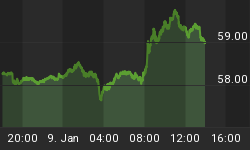Given the recent move to new highs in gold, I feel that a brief discussion on this topic is in order. As everyone knows, gold made a major bottom in 2001. This is where the most recent secular bull market in gold was obviously born. From a cyclical perspective, this was a 9-year cycle low, which is the dominant longer-term cycle in gold. In reality, this cycle has historically averaged 98.6 months, or 8.2 years in duration from low to low. Within this longer-term cycle there is an annual sub-cycle that has averaged some 11.5 months. Since gold has been freely traded there has consistently been 9 of these annual sub-cycles seen within each of the longer-term 9-year cycles. It is for this reason that I refer to this cycle as the 9-year cycle rather than an 8.2 year cycle. But, regardless of the label we put on it, this cycle has nonetheless historically consisted of 9 annual cycles and has had an average duration of 8.2 years. In the chart below I have marked the last several 9-year cycles as well as the annual sub-cycle lows.

I know that the last 9-year cycle low occurred in April 2001 at 255. Please refer to the monthly gold chart above. History also shows that every 9-year cycle low has been accompanied by a move of specific "DNA Markers." From the April 2001 low to the October 2008 low was 90 months. This is some 8 months short of the average. We know that cycles contract and expand so this alone is not justification to say that the 9-year cycle did not bottom in October 2008. But, the fact that there appears to have only been 8 annual cycles between the 2001 low and the October 2008 low is something that has never occurred and I don't like to count on things that fall outside of the norm and/or that have never occurred. But, if I look at this with an open mind, which I always try to do, then it is possible that the May 2008 low marked an annual cycle low. If so, this would give us the usual 9 annual cycles. But, the problem with this is that if the May 2008 low was a annual cycle low, then the count into the October 2008 low would make that annual cycle only 5 months in total duration and there has never been an annual cycle contraction to only 5 months. So again, this gives us another first, which I'm cautious to count on. A bigger issue with the October 2008 low having marked the 9-year cycle low is that the annual DNA markers that have been seen at other 9-year cycle lows did not occur. I've learned to never say "never," but when we summarize this data it is not suggestive that the 9-year cycle low occurred at the October 2008 low. Rather, I think that this 9-year cycle is stretching just like the 4-year cycle out of the 2002 low did in equities. Therefore, the balance of the evidence suggests that we are now in uncharted waters with gold and there is no precedence of what is now occurring. The key at this point is to merely follow my monthly and weekly CTI for direction. As long as the CTI is positive, higher prices will remain possible. Once the weekly CTI turns down, the intermediate-term trend will turn and if any such downturn turns the monthly CTI down, then at that time this extended 9-year cycle will be at risk of peaking. In the meantime, the 9-year cycle advance that began in 2001 has been resurrected and the push into the extended 9-year cycle peak lives on.
I have begun doing free Friday market commentary that is available at www.cyclesman.info/Articles.htm so please begin joining me there. The specifics on Dow theory, my statistics, model expectations, and timing are available through a subscription to Cycles News & Views and the short-term updates. I have gone back to the inception of the Dow Jones Industrial Average in 1896 and identified the common traits associated with all major market tops. Thus, I know with a high degree of probability what this bear market rally top will look like and how to identify it. These details are covered in both the September and the October research letters and will cover this in future letters as this all unfolds. I also provide important turn point analysis using the unique Cycle Turn Indicator on the stock market, the dollar, bonds, gold, silver, oil, gasoline, the XAU and more. A subscription includes access to the monthly issues of Cycles News & Views covering the Dow theory, and very detailed statistical based analysis plus updates 3 times a week.
















